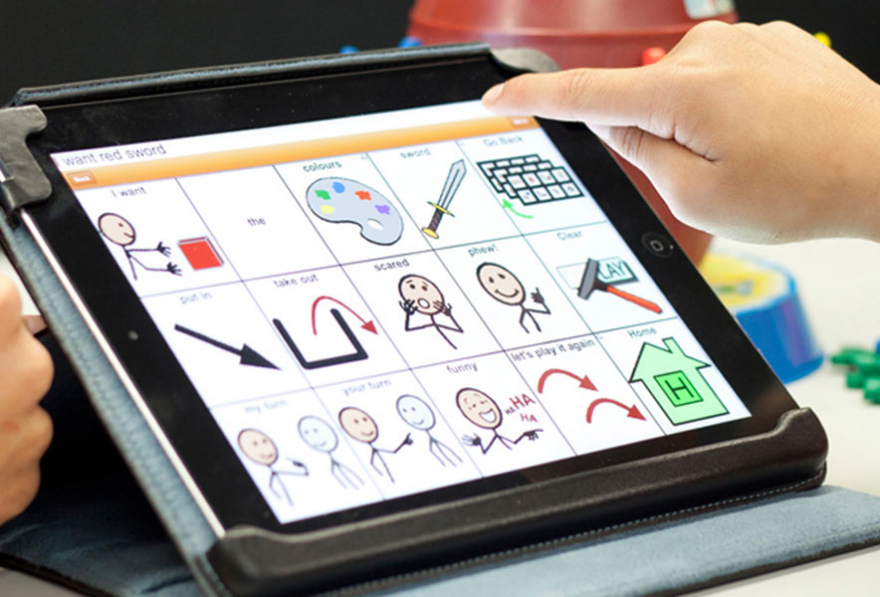Ideas for using an AAC in your sessions!
When you live in a pediatric therapy world as a therapist, several questions come up fairly regularly. For example, “Really, how many times can one use hand sanitizer in one day before your skin comes off”. “Wait, you threw up THIS morning and didn’t go to school?”. “How can I expect people to follow a home exercise program when I can’t even follow my own exercise program?”. “What is that west spot on the carpet in Therapy Room 12 – is it water? Bubbles? Hmmm”.
Another question some therapists wrestle with is, “When my little client shows u for therapy with his AAC, how can I use this in my session? Can I use it in such a way that the therapeutic goals are being addressed? Could I be using it more effectively?” I’m not really doing speaking therapy. Basically, how can I add high-tech Augmentative and Alternative Communication (AAC) into my sessions, even if I’m not in speech therapy?
First, let’s start with a quick definition of AAC. According to ASHA (The American Speech-Language-Hearing Association), “AAC means all of the ways that someone communicates besides talking. People of all ages can use AAC if they have trouble with speech or language skills. Augmentative means to add to someone’s speech. Alternative means to be used instead of speech. Some people use AAC throughout their life. Others may use AAC only for a short time, like when they have surgery and can’t talk.
There are a lot of different types of AAC. No-tech and low-tech options include things like gestures and facial expressions, writing, drawing, spelling words by pointing to letters, and pointing to photos, pictures, or written words.
High-tech options include things like using an app on an iPad or tablet to communicate and using a computer with a “voice,” sometimes called a speech-generating device.
A person may use different types of AAC because there are many ways that we all communicate. An AAC system means all of the tools of this type that a person uses.”
So my question remains, as an OT, or PT, or Mental Health Therapist, how can I use, or support the use of, my client’s AAC with all the other things I need to do in my session? Here are some suggestions:
Get to know your clients better. Most frequently, those of us that don’t use AACs or don’t see clients with AACs every day, assume that the main use of this thing is for directing, answering questions, structured academic and pre-academic activities, and making needs known. “Do you want to swing? Yes or No?” or “What would you like to do next?” What is this thing?”. While AACs are perfect for this use, and add tons of speech, facilitate communication and opportunities for real language, they can also be used to really find out about our clients. Ask about favorites. Find common interests. Understand who they are. When you can tailor your activities to your client’s favorites, you can increase both inherent motivations and participation. Win-win.
Create opportunities for practice. A lot of therapists struggle with home programming. Is it appropriate for the family? Too hard? Too easy? Too much? Is anyone actually going to look at it? We can use the AAC to create activities that our clients can use at home to practice their skills, and work toward their goals. Practice makes progress, and fun practice can increase engagement and investment in the home program. More fun=more practice. Many therapists and families report better outcomes and higher satisfaction rates when their homework is contextual and personally relevant.
Motivation and Encouragement. We can create a folder of progress that our clients and families and refer to when they need reminders (we all need reminders) about how much progress they’ve made. Think about creating a video of your client doing an activity or saying a word or phrase that is tough for them. As they progress through their goals, they can go back and look at how far they’ve come. This can work for OTs and PTs as well as Speech-Language Pathologists.
Improving our best practices. The AAC can be used to effectively and efficiently connect with other members of a client’s team including Physician, other therapists, teachers, specialists, etc. Instead of a communication notebook from school, the teacher can use the AAC to communicate with families. Also, using the AAC in this way encourages our clients to have the AAC with them across their environments, and not leave it behind – solving a problem many clients and therapists report.
Demonstrate the skilled nature of therapy. For many reasons, and in many situations, it is important to show the therapy we provide is a skilled service. We can create a folder on the AAC for parents/families to show their physician to help support them in their medical journey. With this device, we can communicate directly with doctors about our clients, providing an avenue for direct communication, saving others from being the go-betweens and translators.
Don’t forget, when you have a high-tech AAC device at your disposal, you can have the full power of your laptop/phone/table in the capacity of the device. It’s not just about labelling and yes/no choices – it can be so much more.

